Abstract
Although the importance of mixed micelles in the solubilization and biliary excretion of lipids is established, little is known about a possible role of mixed micelles in the excretion of other biliary solutes. Ultrafiltration and ultracentrifugation techniques were used to investigate the interaction between substances that are excreted in bile and biliary mixed micelles. Substances (urea, erythritol, sucrose) excreted in bile at concentrations equal to, or less than, that in plasma did not show an association with mixed micelles, whereas substances (indocyanine green, iopanoic acid, rose bengal, unconjugated and conjugated sulfobromophthalein, and conjugated bilirubin) excreted in bile at high concentration relative to plasma did. The percentage of these latter substances in bile associated with micelles varied from 26 to 93% and was relatively independent of concentration. In addition to their association with mixed micelles, these test solutes formed self-aggregates that were stabilized primarily by ionic bonds, and only a small percentage (range = 0-5%) of these solutes were present in bile in the form of monomer or complexes small enough to pass a 5,000-mol wt membrane.
These findings offer a possible explanation for the increase in sulfobromophthalein, bilirubin, and indocyanine green maximal biliary excretory rate produced by bile salt infusion, and suggest that the concentrative transport into bile of endogenous compounds and xenobiotics may result from their incorporation into mixed micelles and other macromolecular complexes.
Full text
PDF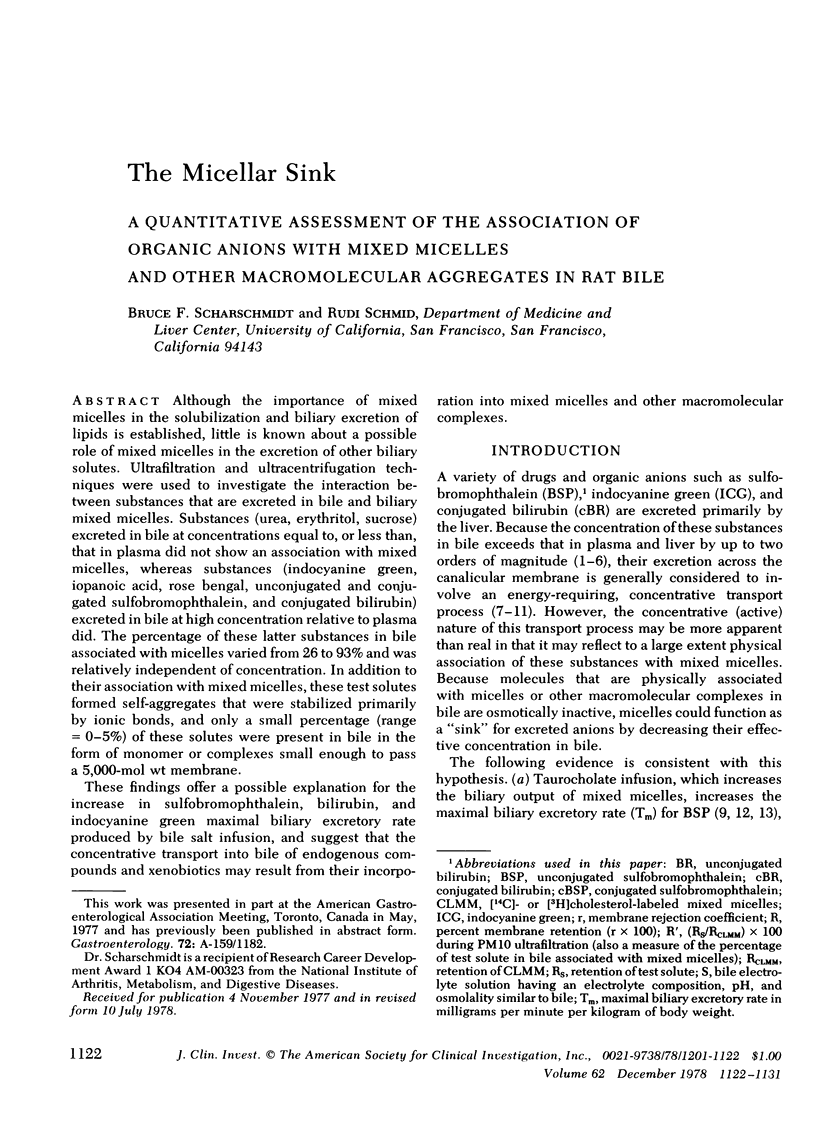
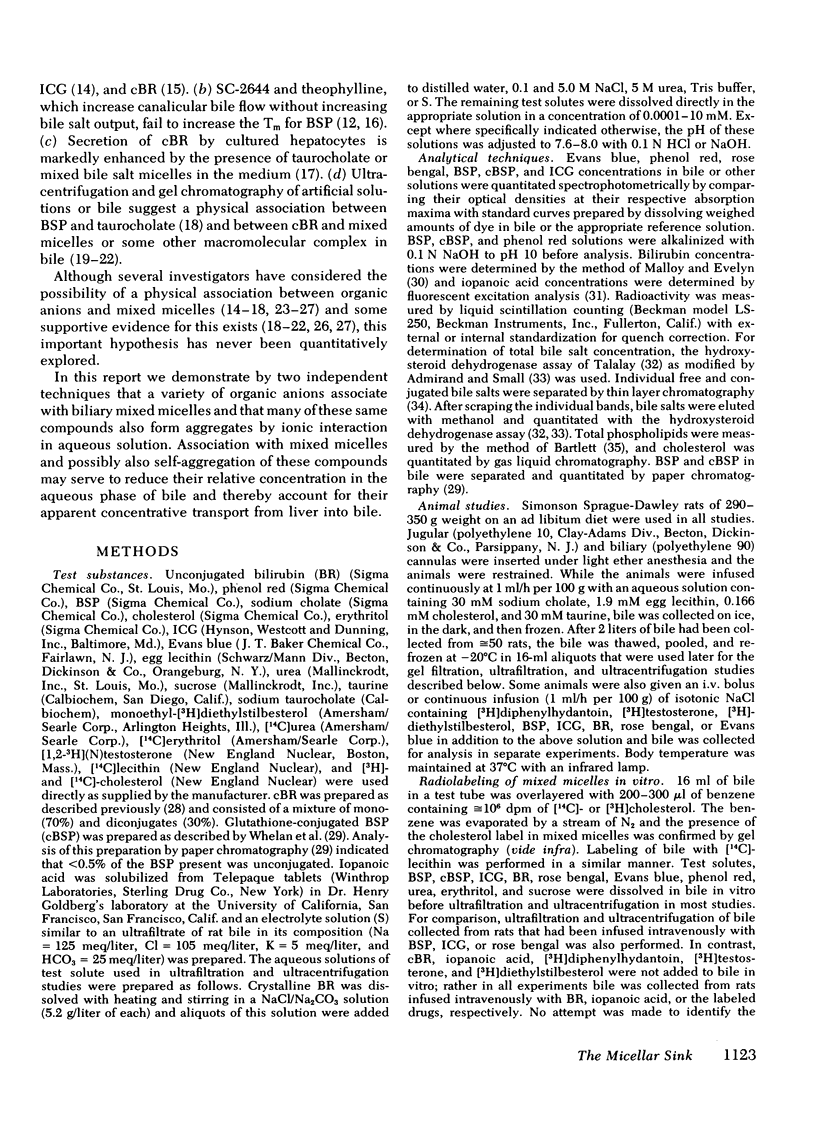
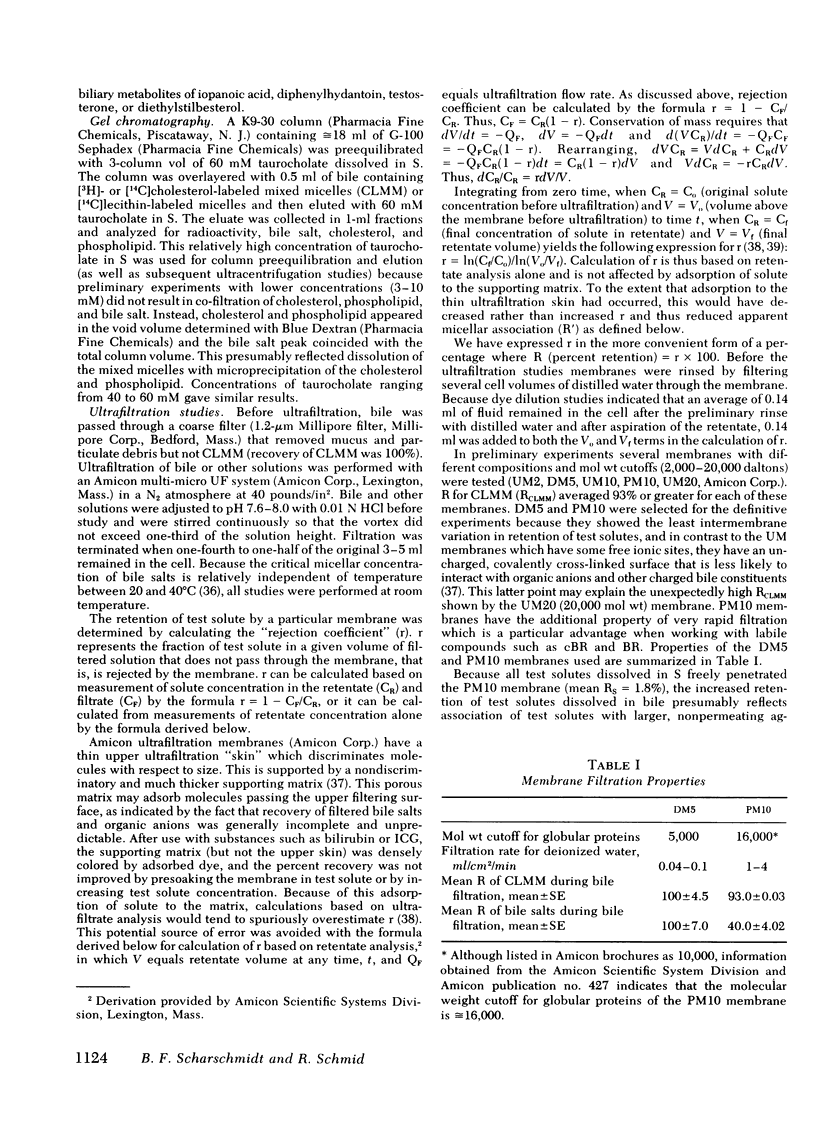
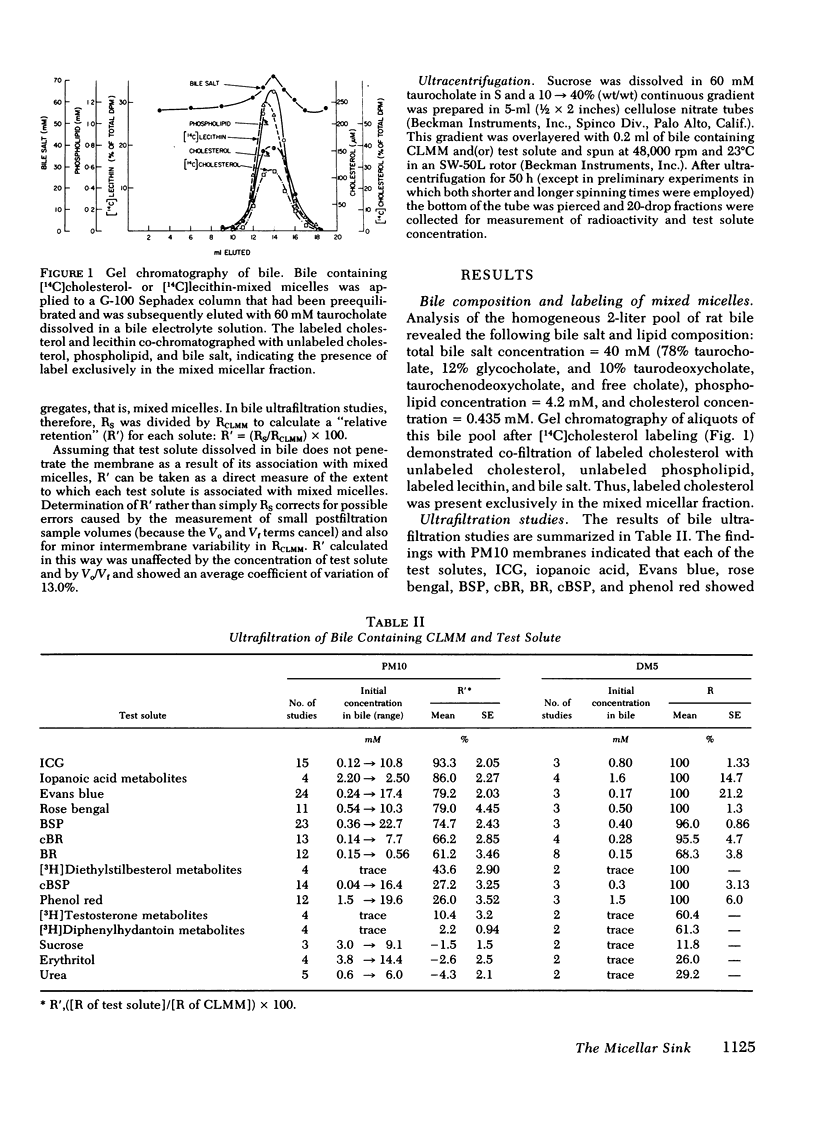
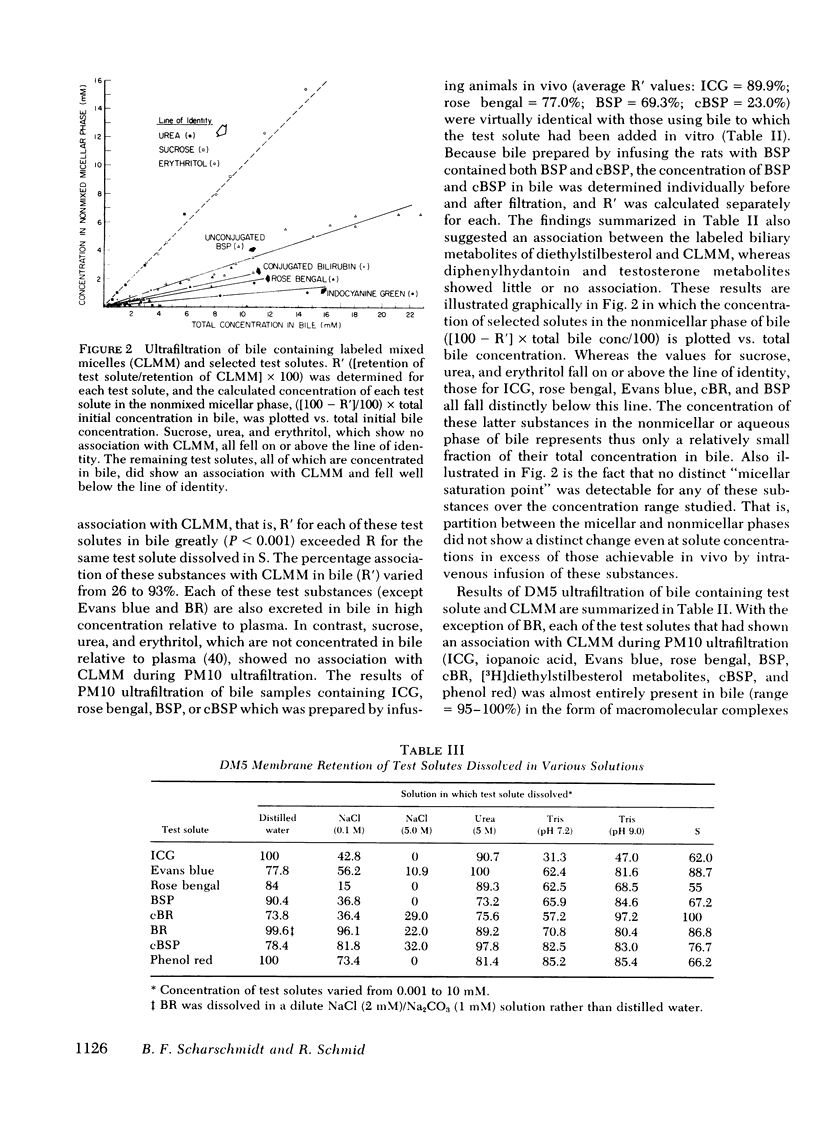
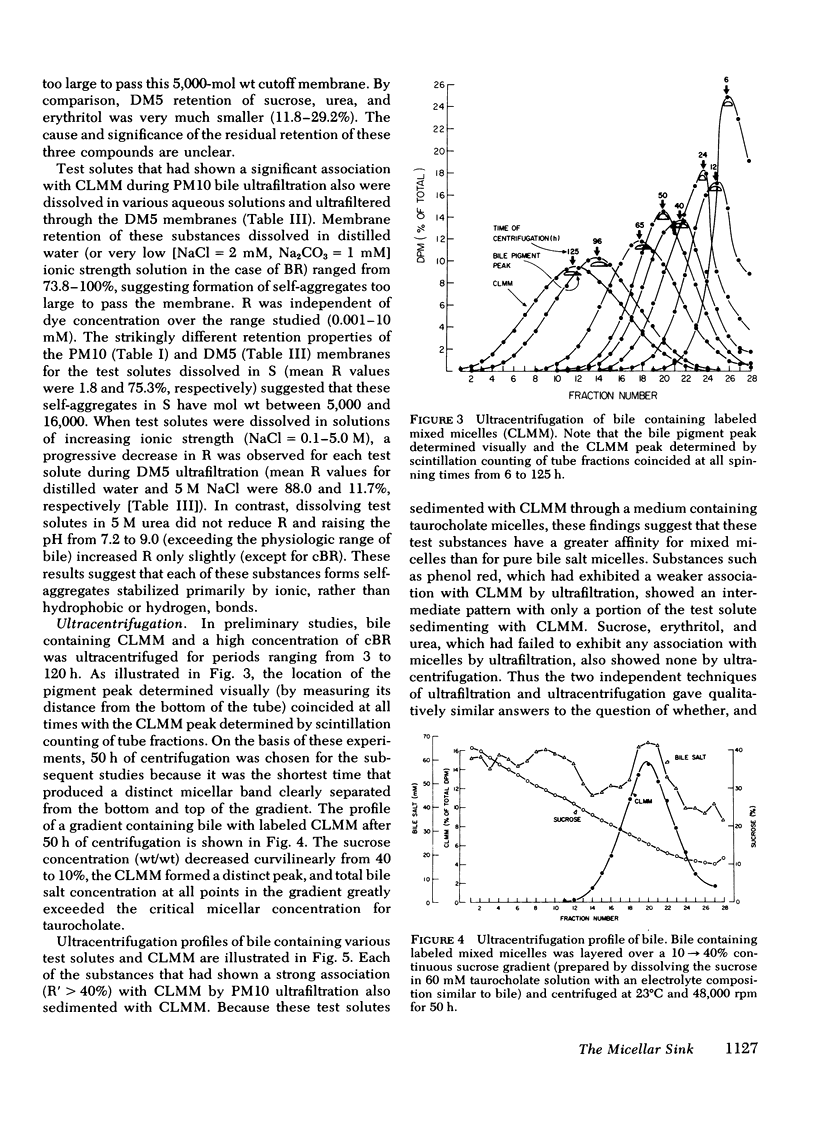
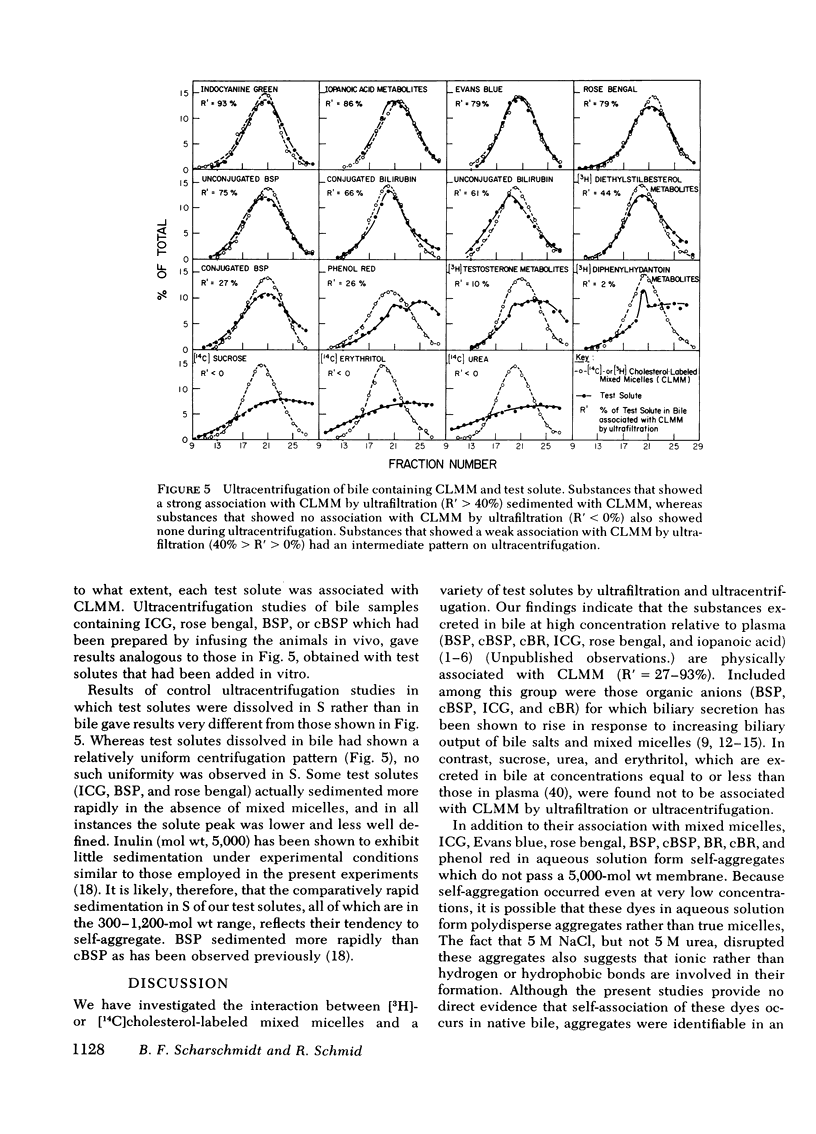
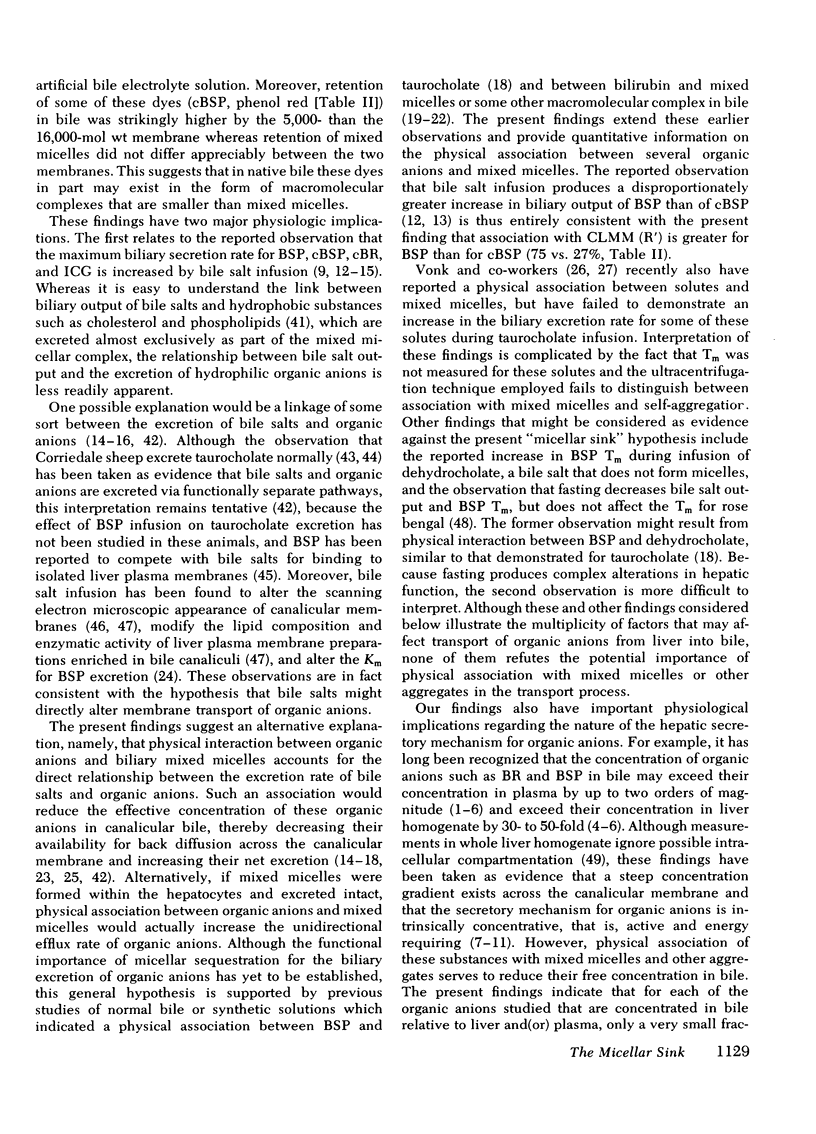
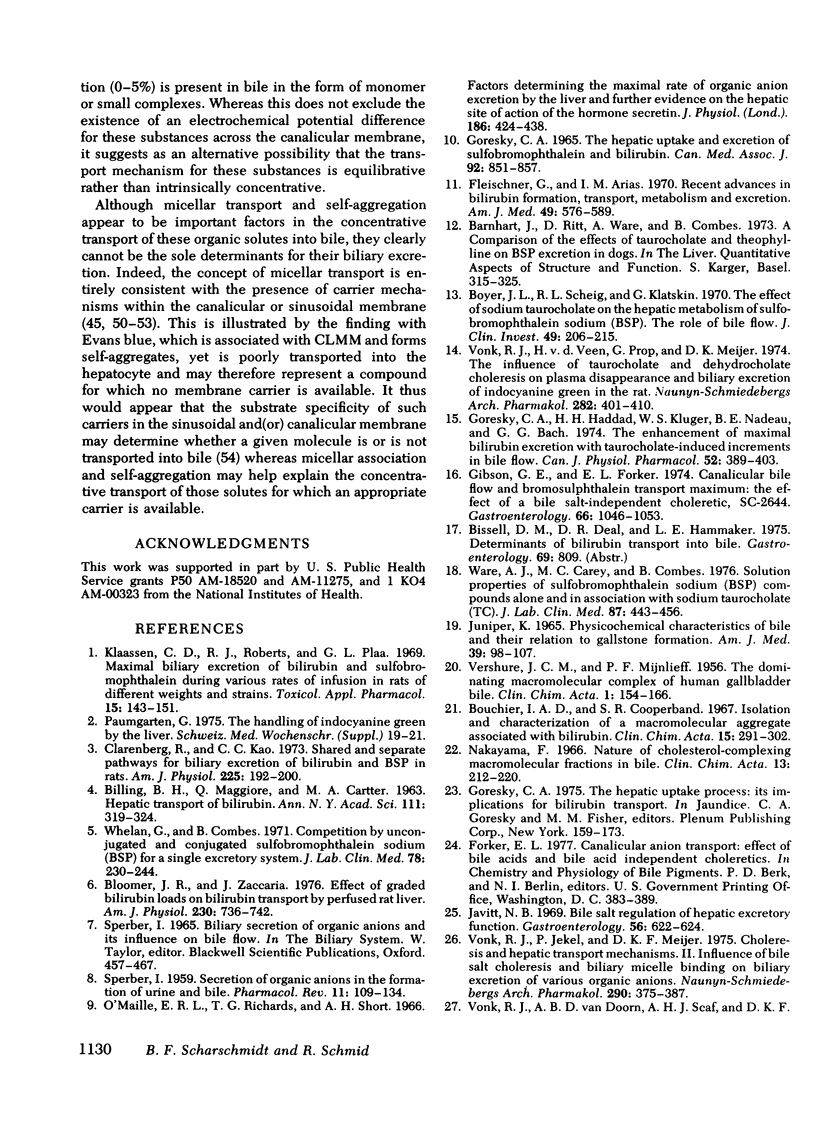
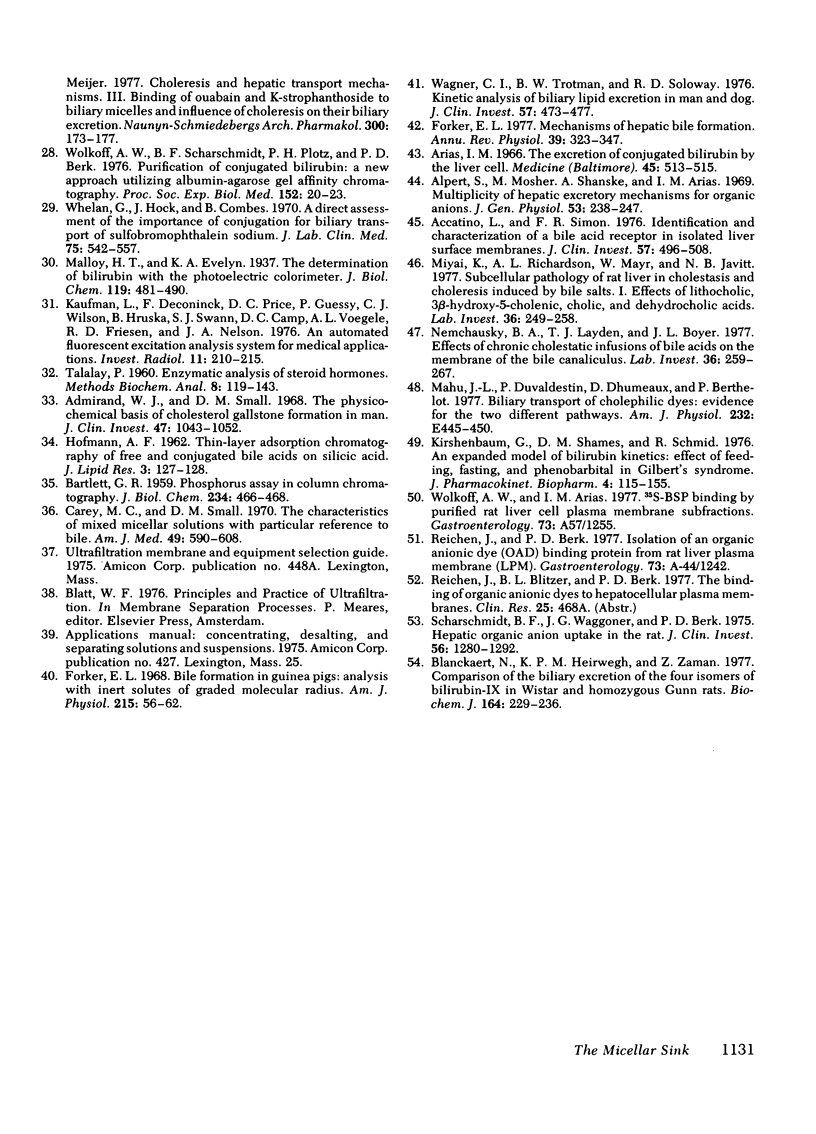
Selected References
These references are in PubMed. This may not be the complete list of references from this article.
- Accatino L., Simon F. R. Identification and characterization of a bile acid receptor in isolated liver surface membranes. J Clin Invest. 1976 Feb;57(2):496–508. doi: 10.1172/JCI108302. [DOI] [PMC free article] [PubMed] [Google Scholar]
- Admirand W. H., Small D. M. The physicochemical basis of cholesterol gallstone formation in man. J Clin Invest. 1968 May;47(5):1043–1052. doi: 10.1172/JCI105794. [DOI] [PMC free article] [PubMed] [Google Scholar]
- Alpert S., Mosher M., Shanske A., Arias I. M. Multiplicity of hepatic excretory mechanisms for organic anions. J Gen Physiol. 1969 Feb;53(2):238–247. doi: 10.1085/jgp.53.2.238. [DOI] [PMC free article] [PubMed] [Google Scholar]
- Arias I. M. The excretion of conjugated bilirubin by the liver cell. Medicine (Baltimore) 1966 Nov;45(6):513–515. doi: 10.1097/00005792-196645060-00015. [DOI] [PubMed] [Google Scholar]
- BARTLETT G. R. Phosphorus assay in column chromatography. J Biol Chem. 1959 Mar;234(3):466–468. [PubMed] [Google Scholar]
- BILLING B. H., MAGGIORE Q., CARTTER M. A. HEPATIC TRANSPORT OF BILIRUBIN. Ann N Y Acad Sci. 1963 Dec 30;111:319–325. doi: 10.1111/j.1749-6632.1963.tb36974.x. [DOI] [PubMed] [Google Scholar]
- Blanckaert N., Heirwegh K. P., Zaman Z. Comparison of the biliary excretion of the four isomers of bilirubin-IX in Wistar and homozygous Gunn rats. Biochem J. 1977 Apr 15;164(1):229–236. doi: 10.1042/bj1640229. [DOI] [PMC free article] [PubMed] [Google Scholar]
- Bloomer J. R., Zaccaria J. Effect of graded bilirubin loads on bilirubin transport by perfused rat liver. Am J Physiol. 1976 Mar;230(3):736–742. doi: 10.1152/ajplegacy.1976.230.3.736. [DOI] [PubMed] [Google Scholar]
- Boyer J. L., Scheig R. L., Klatskin G. The effect of sodium taurocholate on the hepatic metabolism of sulfobromophthalein sodium (BSP). The role of bile flow. J Clin Invest. 1970 Feb;49(2):206–215. doi: 10.1172/JCI106229. [DOI] [PMC free article] [PubMed] [Google Scholar]
- Carey M. C., Small D. M. The characteristics of mixed micellar solutions with particular reference to bile. Am J Med. 1970 Nov;49:590–608. doi: 10.1016/s0002-9343(70)80127-9. [DOI] [PubMed] [Google Scholar]
- Clarenburg R., Kao C. C. Shared and separate pathways for biliary excretion of bilirubin and BSP in rats. Am J Physiol. 1973 Jul;225(1):192–200. doi: 10.1152/ajplegacy.1973.225.1.192. [DOI] [PubMed] [Google Scholar]
- Fleischner G., Arias I. M. Recent advances in bilirubin formation, transport, metabolism and excretion. Am J Med. 1970 Nov;49:576–589. doi: 10.1016/s0002-9343(70)80126-7. [DOI] [PubMed] [Google Scholar]
- Forker E. L. Bile formation in guinea pigs: analysis with inert solutes of graded molecular radius. Am J Physiol. 1968 Jul;215(1):56–62. doi: 10.1152/ajplegacy.1968.215.1.56. [DOI] [PubMed] [Google Scholar]
- Forker E. L. Mechanisms of hepatic bile formation. Annu Rev Physiol. 1977;39:323–347. doi: 10.1146/annurev.ph.39.030177.001543. [DOI] [PubMed] [Google Scholar]
- GORESKY C. A. THE HEPATIC UPTAKE AND EXCRETION OF SULFOBROMOPHTHALEIN AND BILIRUBIN. Can Med Assoc J. 1965 Apr 17;92:851–857. [PMC free article] [PubMed] [Google Scholar]
- Gibson G. E., Forker E. L. Canalicular bile flow and bromosulfophthalein transport maximum: the effect of a bile salt-independent choleretic, SC-2644. Gastroenterology. 1974 May;66(5):1046–1053. [PubMed] [Google Scholar]
- Goresky C. A., Haddad H. H., Kluger W. S., Nadeau B. E., Bach G. G. The enhancement of maximal bilirubin excretion with taurocholate-induced increments in bile flow. Can J Physiol Pharmacol. 1974 Jun;52(3):389–403. doi: 10.1139/y74-055. [DOI] [PubMed] [Google Scholar]
- JUNIPER K., Jr PHYSICOCHEMICAL CHARACTERISTICS OF BILE AND THEIR RELATION TO GALLSTONE FORMATION. Am J Med. 1965 Jul;39:98–107. doi: 10.1016/0002-9343(65)90249-4. [DOI] [PubMed] [Google Scholar]
- Javitt N. B. Bile salt regulation of hepatic excretory function. Gastroenterology. 1969 Mar;56(3):622–625. [PubMed] [Google Scholar]
- Kaufman L., Deconinck F., Price D. C., Guesry P., Wilson C. J., Hruska B., Swann S. J., Camp D. C., Voegele A. L., Friesen R. D. An automated fluorescent excitation analysis system for medical applications. Invest Radiol. 1976 May-Jun;11(3):210–215. doi: 10.1097/00004424-197605000-00009. [DOI] [PubMed] [Google Scholar]
- Kirshenbaum G., Shames D. M., Schmid R. An expanded model of bilirubin kinetics: effect of feeding, fasting, and phenobarbital in Gilbert's syndrome. J Pharmacokinet Biopharm. 1976 Apr;4(2):115–155. doi: 10.1007/BF01086150. [DOI] [PubMed] [Google Scholar]
- Klaassen C. E., Roberts R. J., Plaa G. L. Maximal biliary excretion of bilirubin and sulfobromophthalein during various rates of infusion in rats of different weights and strains. Toxicol Appl Pharmacol. 1969 Jul;15(1):143–151. doi: 10.1016/0041-008x(69)90142-2. [DOI] [PubMed] [Google Scholar]
- Mahu J. L., Duvaldestin P., Dhumeaux D., Berthelot P. Biliary transport of cholephilic dyes: evidence for two different pathways. Am J Physiol. 1977 May;232(5):E445–E450. doi: 10.1152/ajpendo.1977.232.5.E445. [DOI] [PubMed] [Google Scholar]
- Miyai K., Richardson A. L., Mayr W., Javitt N. B. Subcellular pathology of rat liver in cholestasis and choleresis induced by bile salts. 1. Effects of lithocholic, 3beta-hydroxy-5-cholenoic, cholic, and dehydrocholic acids. Lab Invest. 1977 Mar;36(3):249–258. [PubMed] [Google Scholar]
- Nakayama F. Nature of cholesterol-complexing macromolecular fractions in bile. Clin Chim Acta. 1966 Feb;13(2):212–220. doi: 10.1016/0009-8981(66)90295-6. [DOI] [PubMed] [Google Scholar]
- Nemchausky B. A., Layden T. J., Boyer J. L. Effects of chronic choleretic infusions of bile acids on the membrane of the bile canaliculus. A biochemical and morphologic study. Lab Invest. 1977 Mar;36(3):259–267. [PubMed] [Google Scholar]
- O'Máille E. R., Richards T. G., Short A. H. Factors determining the maximal rate of organic anion secretion by the liver and further evidence on the hepatic site of action of the hormone secretin. J Physiol. 1966 Oct;186(2):424–438. doi: 10.1113/jphysiol.1966.sp008044. [DOI] [PMC free article] [PubMed] [Google Scholar]
- SPERBER I. Secretion of organic anions in the formation of urine and bile. Pharmacol Rev. 1959 Mar;11(1):109–134. [PubMed] [Google Scholar]
- Scharschmidt B. F., Waggoner J. G., Berk P. D. Hepatic organic anion uptake in the rat. J Clin Invest. 1975 Nov;56(5):1280–1292. doi: 10.1172/JCI108204. [DOI] [PMC free article] [PubMed] [Google Scholar]
- TALALAY P. Enzymic analysis of steroid hormones. Methods Biochem Anal. 1960;8:119–143. doi: 10.1002/9780470110249.ch3. [DOI] [PubMed] [Google Scholar]
- VERSCHURE J. C., MIJNLIEFF P. F. The dominating macromolecular complex of human gallbladder bile. Clin Chim Acta. 1956 Mar;1(2):154–166. doi: 10.1016/0009-8981(56)90031-6. [DOI] [PubMed] [Google Scholar]
- Vonk R. J., Jekel P., Meijer D. K. Choleresis and hepatic transport mechanisms. II. Influence of bile salt choleresis and biliary micelle binding on biliary excretion of various organic anions. Naunyn Schmiedebergs Arch Pharmacol. 1975;290(4):375–387. doi: 10.1007/BF00499950. [DOI] [PubMed] [Google Scholar]
- Vonk R. J., Van Doorn A. B., Scaf A. H., Meijer D. K. Choleresis and hepatic transport mechanisms. III. Binding of ouabain and K-strophanthoside to biliary micelles and influence of choleresis on their biliary excretion. Naunyn Schmiedebergs Arch Pharmacol. 1977 Nov;300(2):173–177. doi: 10.1007/BF00505048. [DOI] [PubMed] [Google Scholar]
- Vonk R. J., Veen H vd, Prop G., Meijer D. K. The influence of taurocholate and dehydrocholate choleresis on plasma disappearance and biliary excretion of indocyanine green in the rat. Naunyn Schmiedebergs Arch Pharmacol. 1974;282(4):401–410. doi: 10.1007/BF00500988. [DOI] [PubMed] [Google Scholar]
- Wagner C. I., Trotman B. W., Soloway R. D. Kinetic analysis of biliary lipid excretion in man and dog. J Clin Invest. 1976 Feb;57(2):473–477. doi: 10.1172/JCI108299. [DOI] [PMC free article] [PubMed] [Google Scholar]
- Ware A. J., Carey M. C., Combes B. Solution properties of sulfobromophthalein sodium (BSP) compounds alone and in association with sodium taurocholate (TC). J Lab Clin Med. 1976 Mar;87(3):443–456. [PubMed] [Google Scholar]
- Whelan G., Combes B. Competition by unconjugated and conjugated sulfobromophthalein sodium (BSP) for transport into bile. Evidence for a single excretory system. J Lab Clin Med. 1971 Aug;78(2):230–244. [PubMed] [Google Scholar]
- Whelan G., Hoch J., Combes B. A direct assessment of the importance of conjugation for biliary transport of sulfobromophthalein sodium. J Lab Clin Med. 1970 Apr;75(4):542–557. [PubMed] [Google Scholar]
- Wolkoff A. W., Scharschmidt B. F., Plotz P. H., Berk P. D. Purification of conjugated bilirubin: a new approach utilizing albumin-agarose gel affinity chromatography. Proc Soc Exp Biol Med. 1976 May;152(1):20–23. doi: 10.3181/00379727-152-39318. [DOI] [PubMed] [Google Scholar]


